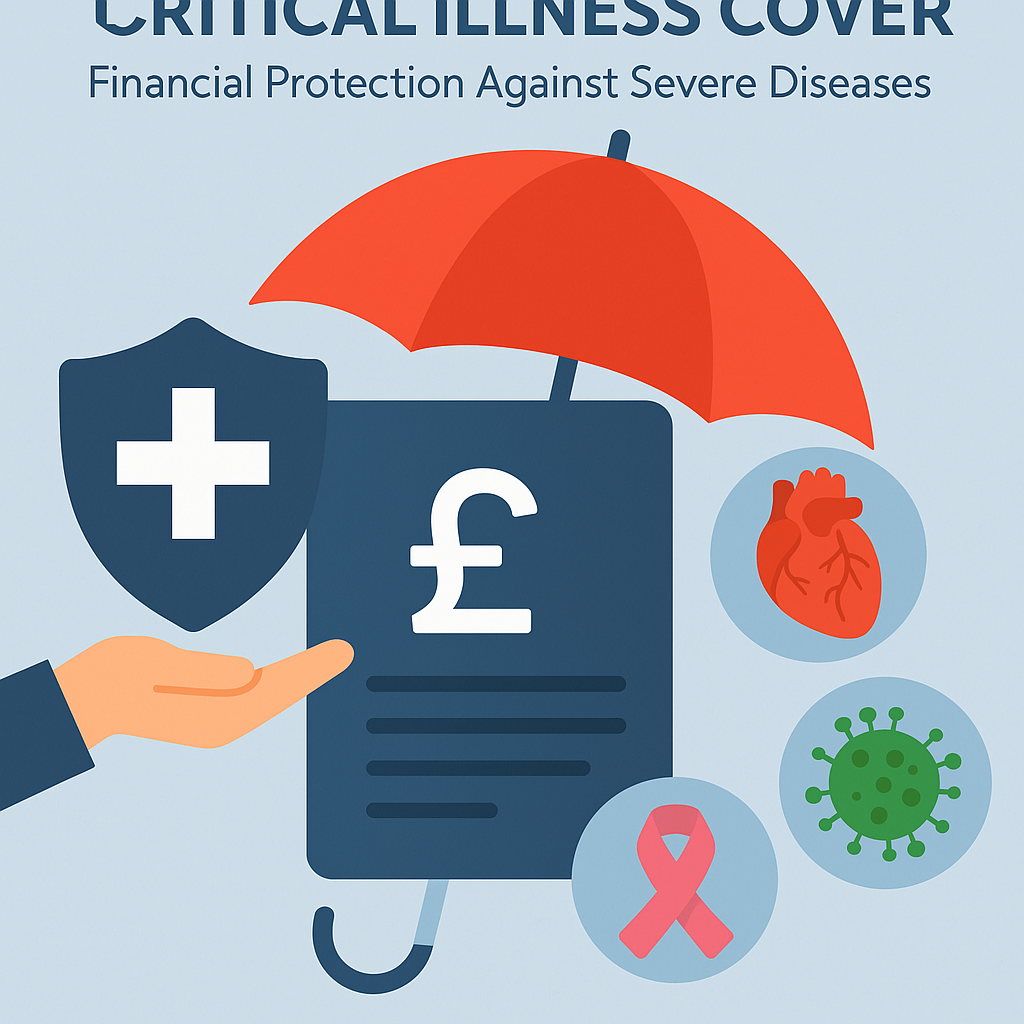Critical illness cover provides a lump-sum payout for severe diseases like cancer and heart attacks, easing financial stress and ensuring focus on recovery.
What is Critical Illness Cover?
Critical illness cover is a type of insurance that provides a one-time payout upon diagnosis of specific severe medical conditions listed in the policy. Unlike regular health insurance, which covers hospitalization expenses, this insurance provides financial assistance to cover treatment, lost income, and lifestyle adjustments required due to illness.

Key Features of Critical Illness Cover
- Lump-Sum Payment: The insured receives a tax-free lump sum after a confirmed diagnosis.
- Covers Major Illnesses: Includes conditions like cancer, heart disease, stroke, kidney failure, and organ transplants.
- No Restrictions on Fund Usage: The payout can be used for medical treatment, paying debts, household expenses, or any other financial needs.
- Available as a Standalone or Rider Policy: Can be purchased separately or as an add-on to an existing life or health insurance policy.
Importance of Critical Illness Cover
- Rising Medical Costs: Treatment for severe diseases can cost thousands of dollars, burdening families financially.
- Income Replacement: If the policyholder is unable to work, the payout ensures they can manage expenses.
- Covers Expensive Treatments: Advanced therapies, surgeries, and long-term rehabilitation can be financially draining.
- Financial Security for Dependents: Helps family members maintain their standard of living in case of job loss due to illness.
Benefits of Critical Illness Cover
- Comprehensive Coverage: Covers major life-threatening illnesses that require expensive treatments.
- Financial Freedom: Policyholders can use the lump sum payout as needed.
- Affordable Premiums: Compared to the benefits, premiums are reasonable and cost-effective.
- Peace of Mind: Provides reassurance that financial needs are covered in case of severe illness.
- Tax Benefits: Premiums and payouts may be tax-exempt in some countries.
How to Choose the Right Critical Illness Policy
Step 1: Assess Your Health Risks
- Consider family history and lifestyle factors that may increase your risk for certain illnesses.
- Evaluate existing health conditions and potential medical expenses.
Step 2: Compare Plans
- Look for policies covering the most critical illnesses, not just common ones.
- Check exclusions and waiting periods.
Step 3: Consider the Sum Insured
- Choose a coverage amount that adequately covers treatment costs and lost income.
- A good rule of thumb is selecting a sum that covers at least 5 years of annual expenses.
Step 4: Check Policy Terms & Exclusions
- Some policies exclude pre-existing conditions.
- Look for clauses related to survival period (the minimum time you must survive post-diagnosis to claim benefits).
Step 5: Buy from a Reputable Insurer
- Choose a company with a high claim settlement ratio and strong financial stability.
Common Mistakes to Avoid
- Not Reading Policy Terms: Many people overlook exclusions, waiting periods, and survival clauses.
- Underestimating Coverage Needs: Choosing a lower sum insured may lead to financial shortfalls.
- Ignoring Waiting Periods: Many policies have a waiting period (e.g., 90 days) before benefits apply.
- Not Updating Coverage: As medical expenses rise, failing to upgrade coverage can be risky.
- Relying Only on Employer Coverage: Employer-provided insurance may not be sufficient or portable if you switch jobs.
Recommended Resources & Tools
- World Health Organization (WHO) – For global health data and statistics.
- [Insurance Regulatory Authorities] – Check local insurance regulations.
- Online Premium Calculators – Many insurers provide premium estimation tools to help you choose the right policy.
Future Trends in Critical Illness Insurance
1. Increased Customization
- Insurers are offering tailored policies based on an individual’s risk profile.
2. Coverage for New Diseases
- Policies are being updated to include newly recognized critical illnesses like long COVID.
3. Tech-Driven Underwriting
- AI and big data analytics are improving risk assessment and pricing models.
4. Wellness-Based Discounts
- Insurers reward healthy lifestyles by offering lower premiums for maintaining fitness and regular health check-ups.
FAQs
1. What is the difference between critical illness cover and health insurance?
Health insurance covers hospitalization and medical expenses, while critical illness cover provides a lump sum payout upon diagnosis of a severe illness.
2. Can I buy critical illness cover if I have a pre-existing condition?
Some insurers may allow coverage with exclusions, while others may decline or charge higher premiums.
3. Does critical illness cover death benefits?
No, critical illness cover is separate from life insurance and does not pay out upon death.
4. Is the payout taxable?
In many countries, the lump sum is tax-free, but it’s advisable to check local regulations.
5. How long does it take to receive the claim amount?
Depending on the insurer, claims are typically processed within 2 to 4 weeks after document verification.
Conclusion
Critical illness cover is essential for financial stability in case of severe diseases. With rising medical costs, having a policy that provides a lump sum payout ensures you can focus on recovery rather than financial stress. When choosing a policy, consider the coverage amount, inclusions, exclusions, and the insurer’s reputation.
Take control of your health today! Compare critical illness policies and secure your future.

